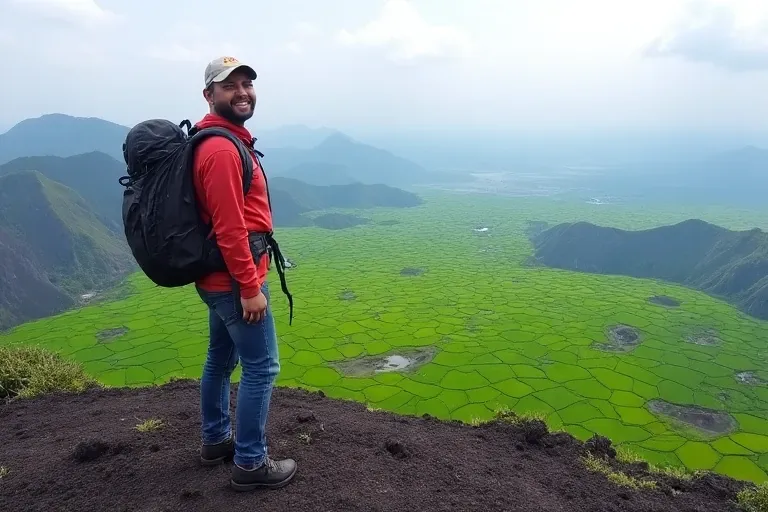Howdy, fellow wanderlusters! Mark here, your seasoned American backpacking buddy, ready to regale you with tales from my recent escapade to Tengchong, a captivating town nestled along the China-Myanmar border. While I've crisscrossed Asia countless times, Tengchong offered a unique blend of history, breathtaking natural beauty, and a culinary adventure that even the most discerning palate would appreciate. My two days in this remarkable place weren't just a trip; they were a complete immersion, and I'm itching to share every delicious detail.
Arrival in Tengchong: A Familiar Feeling, Unexpected Charm
The bus journey into Tengchong brought a wave of déjà vu; the landscape bore a striking resemblance to Dali, a place I'd explored years ago, triggering a flood of nostalgic memories. The familiarity was comforting, yet the subtle differences piqued my interest, hinting at the unique character of Tengchong that awaited me. I settled into a surprisingly budget-friendly hotel (a mere 51 yuan, or roughly $7 USD!). The room was a delightful surprise – spacious, spotlessly clean, and boasting a large, sun-drenched window that framed breathtaking views of the surrounding countryside. It was the perfect sanctuary after my journey. Even the bathroom was surprisingly large – a welcome luxury for a seasoned backpacker like myself. This unexpected comfort set a positive tone for my adventure.
Heshun Ancient Town: A Walk Through History, Marred by Modernity
Leaving behind my cozy hotel, I was drawn to the lush green rice paddies that encircled Tengchong, leading me to the iconic Heshun Ancient Town. The town’s classic aesthetic, a stunning tableau of whitewashed walls and deep-blue tiled roofs, shimmered under the brilliant Yunnan sun. The stark contrast between the verdant rice paddies and the ancient architecture was a visual delight. However, my initial enchantment was somewhat dampened upon discovering the 55 yuan ($7.5 USD) entrance fee. While I've encountered many ancient towns in China, the fee here felt unusual. A chat with a ticket attendant revealed the fee had been in place for two decades, a fact that both surprised and intrigued me. It made me wonder about the delicate balance between preserving history and managing the economic realities of tourism.
Exploring Heshun's Rich Tapestry: Old Meets New
Heshun, with its rich history stretching back over six centuries, is a captivating blend of the old and the new. Its cobblestone streets, impeccably clean, were lined with charming shops showcasing local crafts and goods. I spent a considerable time at the Heshun Library, famously recognized as China's largest rural library. It's a remarkable testament to the town's dedication to education and cultural preservation, showcasing a strong sense of community pride. The library's extensive collection, including rare books and historical documents, offered a glimpse into the intellectual heart of Heshun. The building itself, a beautifully preserved two-story wooden structure, whispered tales of its rich past. The contrast, however, between the historical charm and the rapidly expanding commercial sector was palpable. New buildings sprouted amongst the traditional structures, a reminder of the challenges of balancing preservation with progress. The quaint lanes leading deeper into the town felt like a labyrinth, each turn revealing another delightful surprise, or sometimes, a jarring commercial storefront. This fascinating mix of historical preservation and modern development became a recurring theme during my stay.
Heshun's Heartbeat: A Day Among the Locals
My afternoon in Heshun was a delightful immersion into local life. A chance encounter with a farmer tending his field provided valuable insights into the town's unique character, contrasting it with the more commercially saturated ancient towns like Dali and Lijiang. He spoke passionately about Heshun's ability to retain its authentic charm despite the influx of tourism, a testament to the community's spirit. I witnessed the daily rhythm of life unfolding around me: villagers washing vegetables by the riverbank, drying chickpeas on rooftops, the quiet charm of daily life. I even ventured into a traditional courtyard house, a four-compartment structure, witnessing the blend of old and new. It belonged to an elderly gentleman who had adapted his space by renting parts of it to studios. This experience offered an intimate glimpse into the lives of the people who call Heshun home. The food was delightful and surprisingly affordable, with beef noodles costing around 20 yuan, and local pastries about 12 yuan. The prices were gentle on my wallet, allowing for more exploration.
Tengchong Volcanoes National Geopark: A Volcanic Wonderland
My next adventure was a journey to the Tengchong Volcanoes National Geopark, a dramatic landscape covering an impressive 830 square kilometers. The 35 yuan entrance fee was a small price to pay for the extraordinary experience that awaited me. A 15-yuan shuttle bus whisked me to the base of Dakongshan, one of the park's prominent volcanoes. I opted to hike to the summit, a challenging but deeply rewarding climb. The trek itself was a visual feast, with trails winding through diverse vegetation and offering glimpses of the unique volcanic rock formations. The views from the summit were breathtaking – a panorama of rolling hills, lush greenery, and a distant glimpse of the Myanmar border. The sight was both awe-inspiring and slightly unnerving, a subtle reminder of the volatile geological history of the region. I spent time exploring the unique volcanic rocks, their porous texture a testament to their fiery origins. I then ventured to Xiaokongshan, equally mesmerizing with its even more vibrant vegetation. The air was crisp, and the serenity of the landscape washed away the stresses of city life. The trails were exceptionally well-maintained, and I felt completely safe throughout my explorations.
Tengchong Hot Springs Park: A Geothermal Sanctuary
My final destination was the Tengchong Hot Springs Park, a truly otherworldly experience. Visiting in the late afternoon allowed me the rare luxury of experiencing this geothermal wonderland nearly alone. The 50 yuan entrance fee (about $7 USD) felt insignificant compared to the magnificence of this hidden paradise. The steam rising from countless vents created an ethereal atmosphere, the air thick with the pungent scent of sulfur. The various springs, each boasting unique characteristics, offered a sensory overload. I marvelled at the "Big Boiling Pot" (Da Guoguo), a massive, bubbling cauldron of geothermal water, its constant churning a mesmerizing spectacle. I explored the various pools, from the gently bubbling "Sisters Spring" to the dramatically eruptive "Toad's Mouth" spring. Each spring had a unique personality – some gentle and calm, others fiercely energetic. This was a truly therapeutic experience; the quiet hum of the springs and the soothing heat rejuvenated me. The sheer magnitude and power of nature were profoundly humbling. It felt as though I had stumbled upon a secret garden, a place where time stood still, allowing for deep reflection and connection with the natural world. The experience was a rejuvenating end to my Tengchong adventure.
Tengchong: A Journey Beyond Expectations
My two days in Tengchong were a kaleidoscope of experiences, exceeding even my wildest expectations. The blend of history, nature, and culture created an unforgettable journey. The unexpected commercialization of Heshun, the raw beauty of the volcanoes, and the otherworldly experience of the hot springs – each element contributed to the richness of this less-traveled destination. Tengchong is a place where the past and present intertwine, offering a truly unique travel experience.
Tengchong Trip Summary Table:
| Location | Entrance Fee (Yuan) | Transportation Notes | Key Highlights | Additional Notes |
|---|---|---|---|---|
| Heshun Ancient Town | 55 | Easily accessible from Tengchong city center | Well-preserved architecture, Heshun Library, commercial areas | Unexpected blend of old and new, some commercial overdevelopment |
| Volcanoes Geopark | 35 | Shuttle bus available; hiking is possible | Stunning volcanic craters, panoramic views, unique rock formations | Well-maintained trails, suitable for moderate fitness levels |
| Hot Springs Park | 50 | Public transportation available | Geothermal pools, bubbling vents, unique geological formations | Best visited in the late afternoon for a tranquil experience |







